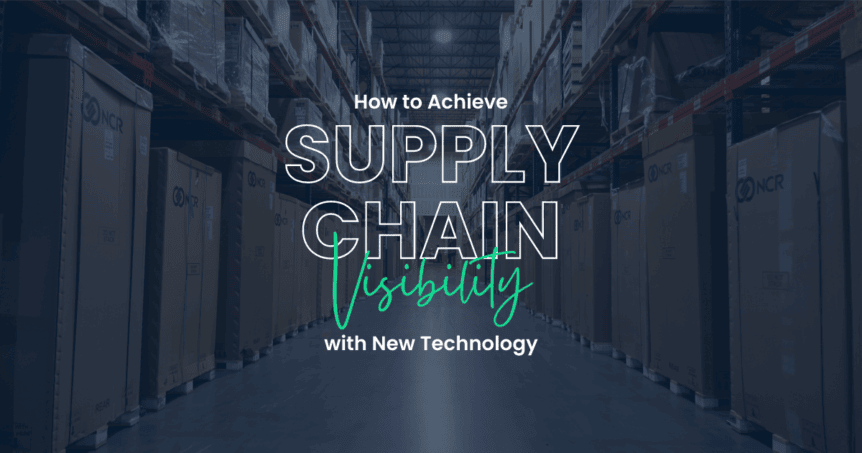Utilizing the latest in technology to improve supply chain and logistics means welcoming the addition of artificial intelligence (AI) into the process. With the help of this new tech, your business could improve data collection, unlock new insights, and reshape the customer experience from end to end.
But, with so much new information and opportunities surrounding AI deployment, most business owners ask: Where should we start? We sat down with industry leaders to walk you through some of the most significant benefits of new tech like AI and how your business can start implementing it.
Table of Contents
Improving Visibility
Your business could implement real-time tracking and minute-by-minute forecasts that utilize millions of data points to improve accuracy with the right tech. It may sound like a thing of the future, but predictive analytics is already upon us with container visibility tools like the kind we use.
You’ll no longer need to guess when a shipment will arrive. Instead, you can fully estimate its arrival, the time it will spend in customs, and when it will finally arrive at its destination.
“With our Container Visibility Tool providing our clients with realistic predictions, they had the information they needed to choose air flight over ocean freight or expedite shipping for products once they made it onshore, or reroute to a different warehouse for faster distribution during the holiday season’s significant delays. It also empowered them to communicate delays with their customers proactively,” adds our Vice President of Technology and Innovation, Bart Bullard.
Fill out this form to learn more about our Container Visibility Tool from our Solution Architect Jake Flory.
Implementing these tools can support your business intelligence (BI) initiatives and, in turn, help your business recognize patterns, adapt to anticipated changes earlier, and ultimately serve your customers better.
Managing Cyber Risks
The wealth of data involved in the supply chain and logistics industry is undeniable. When in the hands of bad actors, this information can be used to gain a competitive advantage or even manipulate the market, ultimately impacting your business and consumers.
In contrast, AI strives to identify vulnerabilities before they are exploited while detecting potential threats as early as possible. When it comes to the supply chain, the advanced protection that AI provides can help eliminate the most severe threats, including corporate espionage.
We are often trusted with early knowledge of marketing campaigns, trade shows, and intellectual property (IP). Even seemingly harmless individuals, such as content creators, would expose this information if it were to be leaked, harming the company’s position in the market and potentially causing them to lose the competitive advantage the success of the campaign or event relies on.
By using AI to keep customer data safe, your business can improve the client and partner experience by ensuring compliance, protecting their intellectual property (IP), and providing a shield around their competitive advantage with new campaigns and projects.
Supporting Security
Achieving robust security, and maintaining it, means continuously implementing the latest technology. That means collaborating with multiple security partners to provide different layers in today’s world.
Aside from contracting the right security partners, it’s also essential that you sit down and discuss your needs with them regularly. Our security team routinely attends round table sessions. As a result, we can continue shaping and improving our best practices.
“We’re currently involved in one proof of concept that’s improving email security. Most email filters will scan the links within an email to determine if they’re safe to go to the inbox or not, but if they pass that check, they don’t scan it again,” explains Bart.
“The concept we’re looking at continues to re-scan emails as long as they’re in the inbox. This is important because bad actors are now sending emails with safe content, so they pass the filter but then change the content at the other end of the link to infect the user with malware. This new scanner will flag anything malicious and prevents mistakes from happening.”
Advances like this are critical in the continued fight against ever-advancing security threats. And it’s more timely than ever, too, given that the supply chain is one of the biggest targets of cyber warfare.
So, don’t treat security as an event—approach it as an ongoing activity. By doing so, both your partners and customers will benefit from early testing and the adoption of advanced security methods.
Advancing IoT
When it comes down to it, technologies like real-time machine learning, artificial intelligence, and the business intelligence that results from them are contributors or byproducts of the Internet of Things (IoT).
By bringing these technologies and algorithms together with smart devices—like secure, temperature-controlled boxes for pharmaceutical shipments—your business will be able to realize incredible results.
In many cases, businesses establish their own IoT scheme, but they still need guidance.
“Many of our clients are coming to us for solutions. To me, the adoption of these IoT devices is exciting because it means the collection of more data, which we turn around and use to power the analytics that provides our clients with greater visibility into the supply chain,” our Solution Architect Jake Flory says.
“Because larger companies often require internal rules that lock their data down, they cannot be flexible with IT and data analytics. They’re dependent on us to serve their supply chain data and feed intelligence to them,” Bart adds.
Continuously implementing new technology and the infrastructure to support it means that more of your partners and clients will begin to see you as a service provider and technological arm that supports their intelligence initiatives and business goals.
Achieve Visibility With Pegasus
So, what’s the next step? Contact our team to learn more about how we’re using new tech like AI to support supply chain visibility and how you can do more of the same.

